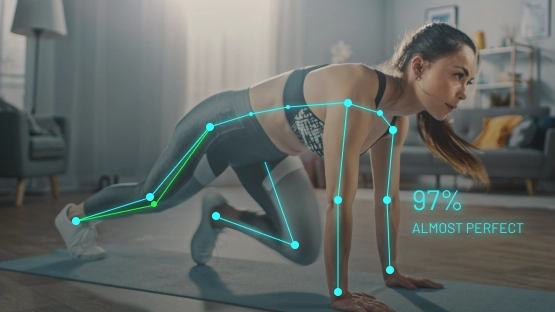AI in Athletics: Transforming the Sports Landscape
Imagine a game where every move is analyzed in real-time, strategies are perfectly planned, and fans are more engaged than ever. This isn’t some fantasy. It is the reality of the sports industry today – and AI is to thank.
In this article, we will discuss all the ways AI is transforming the sports industry both on and off the field.
AI Stats in Sports and Gaming
A study from 2022 showed that the global market value of artificial intelligence in sports was estimated to be around $2.2 billion in that year alone. This figure is expected to reach $29.7 billion by 2032, with an average annual growth rate of 30.1%.

But what is the cause behind this demand and growth? Well, let’s dive into the numerous ways AI is being implemented in sports to find out.
Practical Implementations of AI in Sports
First and foremost, AI is being used to enhance player performance by catering advanced diet plans and personalized training sessions for athletes, analyzing how they play, and helping them avoid injuries.
AI in sports is also used in game strategy development, allowing teams to analyze their opponents, predict potential game outcomes, and help them make informed decisions in real-time. This also includes helping make informed decisions in scouting and recruitment.
But that’s not all. AI is boosting fan engagement and experience through enhanced broadcasting, virtual reality experiences, and delivering personalized content.
Beyond serving athletes and fans, AI is contributing to sports organizations, journalists, referees, and advertisers. Continue reading to find out how.
Improving Player Performance
AI-driven tools can significantly help athletes achieve their peak potential. These tools use large volumes of data to provide insights into player performance. Through personalization, athletes can achieve better results in a short period of time.
Advanced Diet Plans and Personalized Training
AI can create customized nutrition plans and training schedules for athletes based on their individual needs and circumstances. For instance, Getorade Sports Science Institute has developed an AI system called Getorade GX to analyze sweat composition and hydration levels.
The athlete wears a smart patch that transmits data to the app, which then suggests what kind of fluids they should consume during exercise sessions and competition to maintain energy and performance at peak levels.
Biomechanical Analysis
AI gives insights into player movement patterns and recommends adjustments to enhance performance and prevent injuries through the data it collects. This helps athletes train better, improve performance, and reduce injury risks.
Currently, 22 MLB clubs use an AI technology called the K-Motion system. This system analyzes players’ swings and tracks their body movements in 3D, giving detailed feedback and recommendations. This allows athletes to train more effectively and safely using accurate data.
Injury Prevention
AI algorithms can predict future events. This is especially useful in preventing injuries. For instance, several European sports teams, such as Liverpool FC, use the Zone7 platform. This system uses AI to analyze athletes’ health data, such as sleep patterns, training loads, and past injury records.
Then, it uses this information to predict the likelihood of a player getting hurt. It also gives personalized recommendations about how these hazards could be reduced or avoided, keeping them fit and extending their careers.
Nutritional Planning
Through nutritional planning, AI for sports helps athletes maintain their optimal performance. For instance, the European Specialist Sports Nutrition Alliance (ESSNA) partnered with AI-driven platforms to offer athletes personalized nutritional advice.
These platforms analyze various data points, such as training intensity, recovery metrics, and individual health data. The AI then creates personalized nutrition plans that ensure athletes get exactly what they need for their bodies to perform optimally and recover fully.
Game Strategy and Analysis
Sports teams use AI to gain detailed insights into matches and optimize their game strategy in real-time. AI can analyze the opponent’s performance and strategies and predict outcomes. This gives players the opportunity to understand how they should position themselves and the tactics they should adopt in matches, providing a competitive advantage.
Opponent Analysis
AI can conduct detailed opponent analysis, which is very helpful for teams in preparing for their matches. This means that coaches are able to recognize patterns and areas of weakness in the other party, allowing them to come up with unique strategies for every game.

Thanks to AI in sports analytics, teams can also predict what moves the opponent might make since they have gone through large amounts of data from previous matches. This helps them make quick adjustments on how best to exploit this vulnerability in real time, increasing their chances of winning.
For example, Manchester City, among other clubs, uses artificial intelligence software systems to learn how their opponents play, including formations and individual habits.
Predictive Analytics
Predictive analytics offers insights into potential game outcomes, which helps enhance strategic planning. For example, SportsLine’s AI PickBot analyzes historical data and current performance metrics to predict player and team performance.
During the 2024 NBA Finals, it accurately predicted Kyrie Irving’s scoring potential, helping the betters and analysts anticipate his impact in Game 4 against the Boston Celtics.
Real-Time Decision Support
AI provides coaches with real-time decision support during games. One good example is the use of the Second Spectrum in the NBA. This AI system provides real-time data and analytics on player movements, team formations, and opponent strategies during games.
This means that coaches receive instant feedback and tactical suggestions, allowing them to make quick and informed adjustments, like rotating players or changing defensive setups. This ensures teams remain competitive throughout the match.
Scouting and Recruitment
Thanks to the insights that AI provides, scouting talents has never been easier. For example, tools like Statcast in baseball use high-resolution cameras and radar to capture player movements, ball speed, and launch angles.
Similarly, Catapult Sports in soccer uses wearable devices that monitor player movement whenever they train or compete against each other. As a result, talent scouts can make more informed decisions based on the information AI provides about the players’ performance and fitness levels.
Fan Engagement and Experience
Personalization, immersive experiences, and real-time insights are some of the ways AI is transforming fan engagement and experience. These new developments make watching sports more engaging while fostering stronger connections between fans and their favorite teams.
Enhanced Broadcasting
AI provides real-time statistics and insights during live games, enhancing broadcasting. For instance, broadcasters like ESPN use AI to deliver a richer viewing experience with instant replays and in-depth analysis.
AI-driven systems can identify key moments in a game and generate detailed graphics showing the strategies used in different parts of the match and player performance. This makes the broadcast more interactive and informative, effectively engaging fans.
Virtual Reality (VR) Experiences
AI-powered virtual reality provides immersive fan experiences. It allows fans to relive iconic sports moments or attend games virtually, feeling part of the action.
NextVR, for instance, streams NBA games live in VR, allowing fans to watch from different angles as if seated courtside. This technology brings fans closer to events, giving them an alternative way of experiencing live sports.
Personalized Content
AI in the sports industry delivers personalized content based on fans’ preferences. Depending on an individual’s taste, streaming services like DAZN use AI to recommend sports documentaries and live games.
AI also analyzes viewing habits and engagement data to offer viewers content that is most likely to resonate with them. This improves their overall viewing experience and keeps them engaged with their favorite sports and teams.
AI Applications in Sports Management
Artificial intelligence can be applied in several areas of sports management, ranging from ticketing to journalism and broadcasting. These innovations help sports organizations become more efficient while enhancing fan experiences.
Ticketing
AI streamlines the ticketing process by predicting demand and setting dynamic pricing. For example, Ticketmaster’s AI system analyzes historical sales data, market trends, and other factors, like weather conditions, to adjust prices in real time.
This approach ensures that fans get fair ticket prices while maximizing revenue for sports organizations. AI can also detect and prevent fraudulent ticket activities by identifying suspicious purchase patterns, allowing only genuine fans to access tickets.
Automated Sports Journalism
Automated sports journalism produces match reports and analyses in real-time. For instance, the Washington Post uses an AI tool called Heliograf to generate game summaries immediately after the final whistle is blown.
These systems can analyze match data, player statistics, and key moments to create accurate and engaging reports. This enables sports media outlets to deliver news without the delay of traditional reporting methods, keeping fans up-to-date and engaged.
AI Referee
AI referees are being used to support human officials in making correct decisions. For instance, FIFA uses the Video Assistant Referee (VAR) system, which employs artificial intelligence to review real-time plays.
The system analyzes footage from multiple angles to give extra layers of accuracy in officiating. This technology helps referees make more informed decisions on critical calls, such as goals, penalties, and offsides, improving the fairness and integrity of the game.
Live Broadcasting and Advertising
AI can improve live broadcasting and advertising by looking at viewers’ engagement and then targeting ads accordingly. NBC Sports, for example, employs AI to monitor how people react in real time while watching sports events by analyzing data from social media interaction, viewer ratings, and in-app feedback.
Broadcasters then use this data to place ads more effectively, delivering content that resonates well with the audience.
Key Technologies Driving AI in Sports
Various technologies act as the driving force behind AI in sports, each transforming different aspects of the industry. Let’s take a closer look.
Machine Learning
Machine learning algorithms analyze data to identify patterns and make predictions. Many AI applications in sports are built on this technology. We see this applied in advanced diet plans and personalized training, biomechanical analysis, injury prevention, and nutritional planning. We also see it in opponent analysis, predictive analytics, real-time decision support, live broadcasting and advertising, personalized content, and ticketing.
Computer Vision
AI uses computer vision to interpret and understand visual information. In sports, it helps track player movements and analyze game footage. Computer vision is used in biomechanical analysis, scouting and recruitment, enhanced broadcasting, VR experiences, and AI refereeing.
Natural Language Processing (NLP)
NLP allows computers to understand and generate human language. Automated sports journalism, like the Washington Post’s Heliograf, is a prime example of NLP as it analyzes game data and converts it into readable articles within seconds.
Data Privacy and Bias in AI
Despite its numerous benefits, artificial intelligence raises concerns over data privacy. If not adequately protected against unauthorized access, personal information collected from wearable devices during sporting activities may be at risk of being hacked. To avoid data breaches, the NFL has encrypted player data from devices like GPS trackers.
Bias could also be introduced through algorithm development or during data collection. A good example would be facial recognition software showing higher error rates for certain ethnic groups. To address such issues, sports organizations regularly audit and update their AI systems to ensure that all athletes and fans are treated equally, regardless of race or other factors.
Conclusion
So, next time you watch a game, remember – there’s a lot more going on behind the scenes than just raw talent and hard work. AI is the secret weapon, making sports smarter, safer, and more exciting for everyone involved.
Isn’t it fascinating to think about what’s next? Maybe the next big innovation is just around the corner, ready to transform the game even further. Stay tuned because the future of sports is here and powered by AI.
Table of Contents
- AI Stats in Sports and Gaming
- Practical Implementations of AI in Sports
- Improving Player Performance
- Advanced Diet Plans and Personalized Training
- Biomechanical Analysis
- Injury Prevention
- Nutritional Planning
- Game Strategy and Analysis
- Opponent Analysis
- Predictive Analytics
- Real-Time Decision Support
- Scouting and Recruitment
- Fan Engagement and Experience
- Enhanced Broadcasting
- Virtual Reality (VR) Experiences
- Personalized Content
- AI Applications in Sports Management
- Ticketing
- Automated Sports Journalism
- AI Referee
- Live Broadcasting and Advertising
- Key Technologies Driving AI in Sports
- Machine Learning
- Computer Vision
- Natural Language Processing (NLP)
- Data Privacy and Bias in AI
- Conclusion



